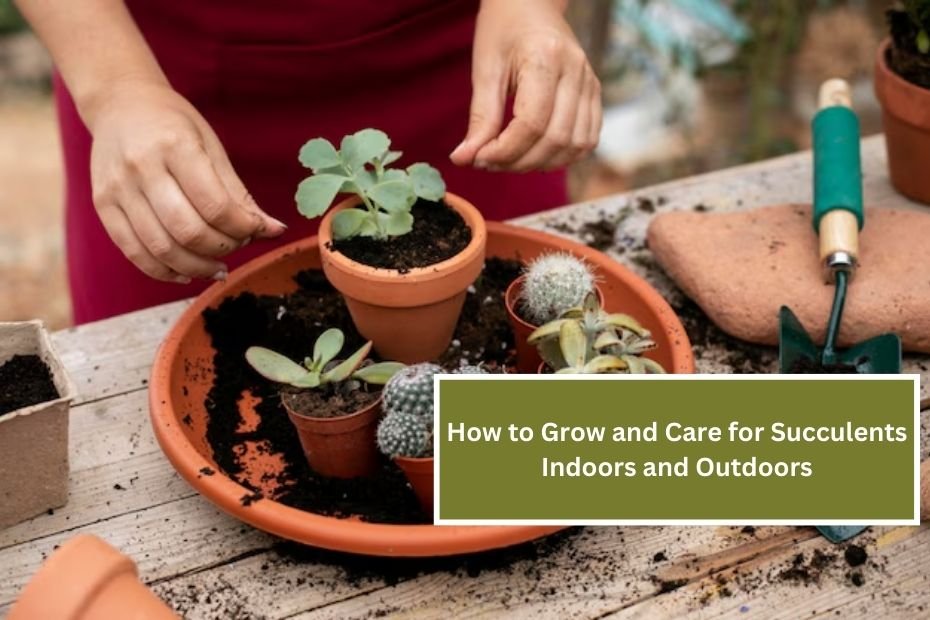Succulents have gained immense popularity due to their unique appearance, ability to thrive in dry conditions, and relatively low-maintenance care. Whether you’re growing succulents indoors as charming houseplants or outdoors as part of a garden, they bring beauty, greenery, and a touch of nature to any space. This guide will take you through everything you need to know about growing and caring for succulents, both inside and outside your home.
What Are Succulents?
Succulents are plants that store water in their thick, fleshy leaves, stems, or roots. They are adapted to survive in environments with limited water supply, making them perfect for indoor spaces and dry outdoor climates. Common succulent varieties include Aloe Vera, Jade Plant, Echeveria, and many types of cacti.
Choosing the Right Succulents
For Indoors
When growing succulents indoors, look for varieties that can tolerate indirect light and adapt well to indoor conditions. Some excellent indoor succulent choices are:
- Aloe Vera: Known for its medicinal properties.
- Jade Plant: A classic, slow-growing succulent.
- Haworthia: A small, low-light tolerant succulent.
For Outdoors
If you plan to grow succulents outdoors, select varieties that are more tolerant of direct sunlight and can survive in your local climate. Great outdoor options include:
- Agave: A large succulent that thrives in bright sunlight.
- Sedum: A versatile, hardy plant that can withstand extreme temperatures.
- Sempervivum (Hens and Chicks): Cold-hardy and ideal for outdoor rock gardens.
Light Requirements
Indoor Succulents
Indoor succulents need plenty of bright, indirect light. Most types do well with 4-6 hours of sunlight each day, but not all succulents can handle direct sunlight, especially if filtered through windows. Place your succulents near a sunny window, preferably one facing south or east, to give them the light they need without the risk of sunburn.
If natural light is limited, consider using a grow light. LED grow lights are energy-efficient and simulate the sunlight that succulents need.
Outdoor Succulents
Outdoor succulents can thrive in full sun, but some species prefer partial shade, especially during the hottest part of the day. In very hot climates, succulents exposed to intense afternoon sunlight may need some protection to avoid scorching. You can provide shade using a cloth or plant them in spots where they’ll get a break from the sun, such as under trees or large shrubs.
Watering Succulents
One of the most important aspects of succulent care is proper watering.
Indoor Watering
Watering succulents indoors can be tricky because they are prone to root rot if overwatered. The general rule is to water them deeply but infrequently. Always let the soil dry out completely between watering sessions. Depending on the humidity and temperature inside your home, you may only need to water your succulents every 1-2 weeks.
Here’s how to water indoor succulents:
- Water thoroughly until you see water draining from the bottom of the pot.
- Empty the drainage tray to prevent water from sitting at the base.
- Always ensure the pot has drainage holes to avoid water accumulation.
Outdoor Watering
Succulents planted outdoors typically need more water than those indoors, especially in dry, hot climates. However, the watering schedule will depend on the climate, season, and the specific succulent species. During the hot summer months, succulents may need to be watered weekly, while in cooler months, they might require watering every few weeks.
If it rains frequently, you may not need to water them at all. Like indoor succulents, the soil must dry out between waterings to prevent root rot.
Soil and Potting
Indoor Succulents
Succulents need well-draining soil to prevent water from sitting around their roots. You can buy cactus or succulent soil mix from a nursery or garden store, or make your own by combining regular potting soil with sand, pumice, or perlite. The ideal mix will allow water to drain quickly and not retain excess moisture.
For indoor succulents, pots with drainage holes are crucial. Without drainage, water can accumulate at the bottom of the pot, causing the roots to rot.
Outdoor Succulents
For outdoor succulents, well-drained soil is equally important. Sandy or rocky soil is ideal as it helps prevent waterlogging. If your garden soil is heavy or clay-like, consider amending it with sand or grit to improve drainage. Raised beds or rock gardens are excellent ways to ensure that outdoor succulents receive good drainage.
Temperature and Humidity
Indoor Conditions
Succulents prefer warm, dry environments, making them perfect for most homes. They generally do well in temperatures ranging from 60°F to 80°F (15°C to 27°C). Keep succulents away from drafty windows and air conditioners, as they are sensitive to sudden temperature changes.
While succulents can handle low humidity levels, they may struggle in very humid indoor environments. To maintain the right balance, avoid placing them in bathrooms or kitchens where moisture levels are high.
Outdoor Conditions
Outdoor succulents are more tolerant of temperature variations, but they still prefer warmer climates. Many species can survive mild frost, but if you live in a region with cold winters, consider moving your potted succulents indoors or covering them during freezing temperatures. Some succulents, like Sempervivum, are frost-hardy and can survive even in snowy conditions.
Fertilizing Succulents
Succulents don’t require a lot of fertilizing, but occasional feeding can boost their growth, especially during the growing season (spring and summer).
Indoor Fertilizing
For indoor succulents, a diluted, balanced fertilizer applied once every two to four weeks during the growing season works best. Use a fertilizer designed for succulents or cacti, and avoid over-fertilizing, as this can cause leggy growth and weaken the plant.
Outdoor Fertilizing
Outdoor succulents can be fertilized in a similar way, though they often need less due to the natural nutrients they get from the soil. For succulents planted in the ground, one to two light feedings per growing season are sufficient.
Repotting Succulents
Over time, succulents will outgrow their containers or need fresh soil to thrive. Repot your succulents every two to three years or when they become root-bound. Here’s how to repot succulents:
- Gently remove the plant from its current pot, taking care not to damage the roots.
- Shake off excess soil from the roots and check for any signs of rot.
- Place the plant in a new pot with fresh, well-draining soil.
- Wait a few days before watering to allow the roots to settle.
For outdoor succulents, you can also move them to new spots in the garden if they start to crowd each other.
Common Pests and Diseases
Succulents are generally pest-resistant, but they can sometimes attract pests such as mealybugs, aphids, or spider mites. These pests feed on the sap of the plant and can cause damage if not addressed.
To treat pests:
- Wipe the affected areas with a cotton swab dipped in rubbing alcohol.
- Use a mild insecticidal soap or neem oil spray to control infestations.
- Remove heavily infested parts of the plant to prevent the spread of pests.
Root rot is another common issue with succulents, typically caused by overwatering. Ensure proper drainage and avoid letting water sit in the soil for long periods.
Conclusion
Growing succulents indoors and outdoors can be a rewarding experience, whether you’re a beginner or an experienced gardener. With proper care, these versatile plants can brighten up your home or garden with their striking shapes and colors. Remember, the key to healthy succulents is giving them the right amount of light, water, and drainage. By following the guidelines in this article, you can enjoy the beauty and benefits of succulents for years to come, whether they’re thriving on your windowsill or in your outdoor garden.

